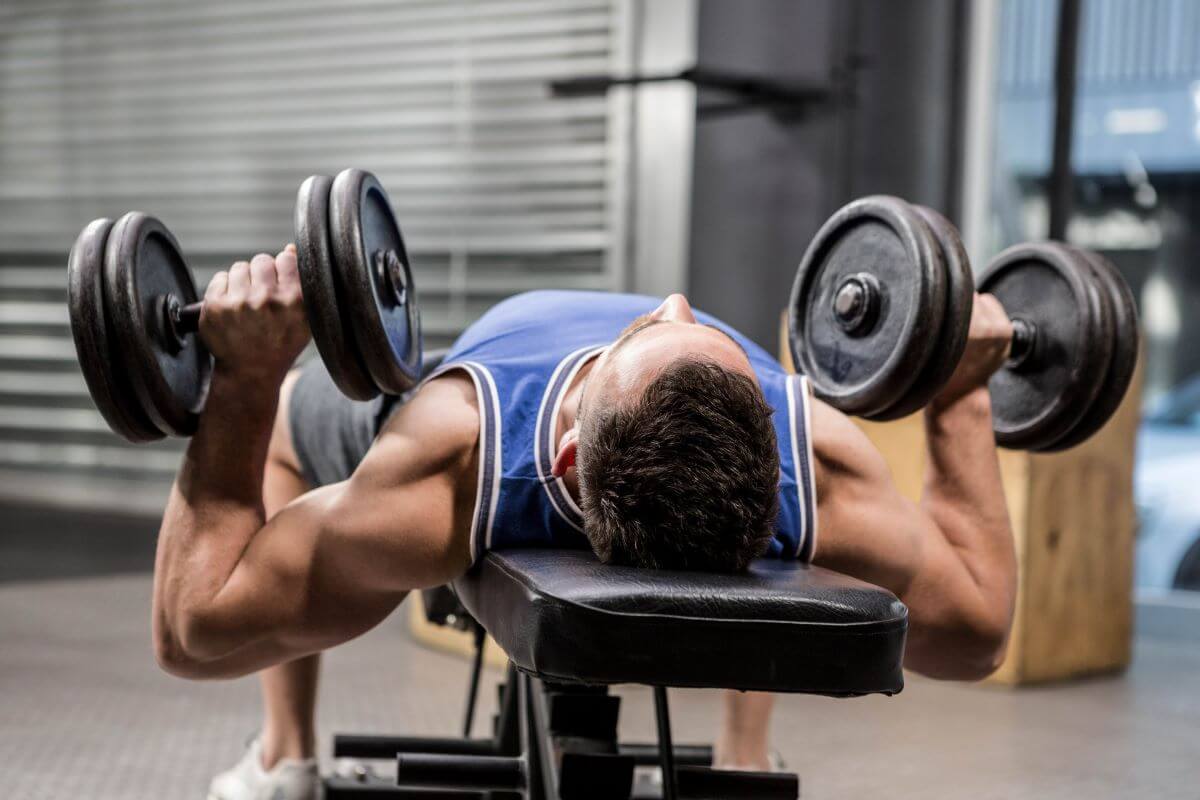The dumbbell bench press is a bench press variation that has been used by gym-goers for decades to build massive chest muscles.
It trains the foundational movement pattern known as the horizontal press and has several benefits when compared to its barbell counterpart.
There’s quite a few variations of the dumbbell bench press and each variation varies in hand/grip placement and the degree of incline/decline used to perform the movement.
Ultimately, picking the best horizontal press movement for yourself will help you make muscle and strength gains in the gym.
In this article, we’re going to cover all things dumbbell bench press. We will tell you how to perform the movement, what muscles the exercise targets, how to incorporate the exercise into your workout routines, and list several variations you can take with you to further explore.
Let’s get started.
How to Perform the Dumbbell Bench Press
To perform the dumbbell bench press exercise, you’re going to need two things. A pair of dumbbells and a flat bench or an adjustable bench set up in a flat position.
- Begin by selecting a pair of dumbbells that will provide a challenging stimulus for the exercise.
- Ensure that the bench is set to a flat bench position.
- Take a position lying down on your back on the flat bench with the dumbbells in your hand at chest level using a pronated grip (palms facing away from you). Your elbows should be bent and your feet should be placed firmly on the floor.
- Using the muscles of your chest, maintain the pronated hand grip and press the dumbbells away from your body until they are directly over your chest.
- Squeeze your pecs hard at the top of the movement while keeping a slight bend in your elbows.
- Reverse the movement and bring the weight back down to chest level keeping the weight under control throughout the range of motion.
- Repeat for the desired number of repetitions.
Some may decide to experiment with grip to determine how they can best target the muscles of the chest. Some may prefer a neutral grip. Some may determine they like rotating the arm during the press to incorporate multiple grips at different positions of the exercise. These are both variations we’ll list in the variation section below that you can look into.
What Muscles Does the Dumbbell Bench Press Work?
The dumbbell bench press primarily works the muscles of chest known as the pec major and pec minor. Due to the extra bit of stretch allowed by the increased range of motion while using dumbbells, some lifters like including this exercise into their workouts to encourage hypertrophy of the muscles.
In addition to the pec muscles, the front deltoids of the shoulders and the triceps are worked as well.
Since the dumbbells provide a greater degree of freedom during the movement, you’ll also indirectly work stabilizing muscles such as your core, shoulders and back.
How to add Dumbbell Bench Press to Your Workouts
Many substitute dumbbell bench press into their workout routines in place of the traditional bench press as it is thought that the unilateral nature of the exercise allows one to build more symmetrical muscles. There’s also a notion that dumbbell bench press carries less of a risk for pec tears than traditional bench press – however, proper form and programming is needed in both exercises to prevent injury.
Thus, the dumbbell bench press might be the primary exercise of your workouts or the secondary exercise. This will depend largely on what style of training split you prefer as well (full body workouts, upper/lower workouts, push/pull/legs workouts, or bro splits).
For those who perform it as a primary movement, they will include it as their first exercise performed for chest on upper workout days, push workout days and full body days.
For those who perform bro-split workouts, it may be the first or second exercise performed.
Generally, you will perform 3-4 sets of 6-12 repetitions when performing dumbbell bench presses. For those performing it as their main exercise, you’ll likely go with 4 sets during your workouts. And for those using it as a secondary exercise, 3 sets will usually suffice.
There will be some who opt for an even lower rep range than 6-12 reps. However, there’s a lot of benefit to using the barbell bench press when maximum strength is your training goal and thus, I don’t personally recommend going lower than 5 repetitions with the dumbbell bench press.
For rest periods in between sets, you’ll want to rest for 1-3 minutes depending on how heavy you are going with the exercise. For those performing the higher rep range listed 60-90 seconds should suffice. For those performing the lower rep range, 2-3 minutes will benefit you.
Dumbbell Bench Press Variations
Listed below are some of the dumbbell bench press variations I know about. It’s worth exploring these to determine which variation best matches your likes and provides you with the best training stimulus as this will lead to consistency in training and better overall results.
As I write more exercise guides, I will like these variations to their articles. In the meantime, feel free to do your own discovery.
- Incline Dumbbell Bench Press
- Decline Dumbbell Bench Press
- Neutral Grip Dumbbell Bench Press
- Rotating Dumbbell Bench Press
- Reverse Grip Dumbbell Bench Press
- Dumbbell Floor Press
Conclusion
The dumbbell bench press is a popular exercise that people have been using for decades. After reading this article, you should have a great understanding of how to perform the movement and what muscle groups it targets.
Additionally, you should have a better understanding of how to add them to your own workout routines.
If you have any questions about the dumbbell bench press exercise or any of the variations listed in the final section, please feel free to leave a comment below.
